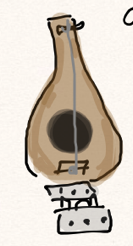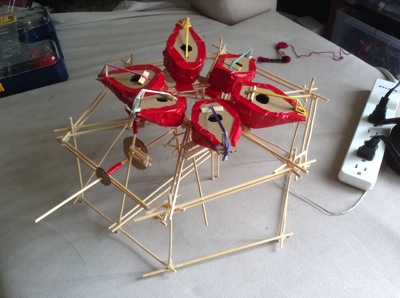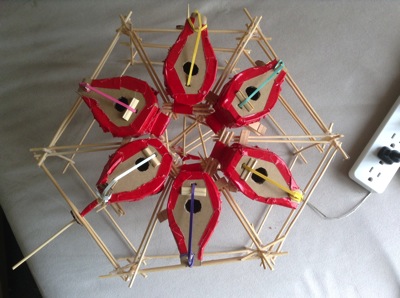As a Maker-in-Residence at the Intel Experience Store, I spent a whole lot of time playing around with motors, and you might recall that one of the projects I developed over the course of my time there was a motorized noisemaker. In February, I started thinking more about rotary instruments, and about how there aren’t nearly enough of them. Enter the Hexachord.
Building an instrument you’ve designed, particularly when you haven’t designed a full, complicated one before makes for a lot of modifications as you go. As I love tinkering, that worked great for me.
The Hexachord is a six-chambered string instrument with a spinning plectrum arm in the center that plucks each resonating chamber as it turns. Each chamber is mounted on a hinge, so that it can be maneuvered in or out of the way of the plectrum arm. This version’s spinning arm is powered by a motor from an old VCR.
 |
 |
As you might imagine, a new instrument this complicated is a difficult thing to get other people to understand while it’s still in the planning stages. I had a rough idea in my mind from the beginning, of course, and I think it helped me develop it each time I tried to explain what it would look like and how it would work.
Getting it out of my head, (very) rough prototyping:
The first prototype was small, less than a foot across (to compare – the final version is over three feet tall), and made from cardboard, duct tape, rubber bands, and dollar store wooden skewers. It’s not so much made to last; it has since fallen to pieces. Cuz, y’know, duct tape.
 |
 |
(The prototype in these pictures doesn’t include the plectrum arm, and is lying on its back, though it’s intended to be on its side with all the sound chambers facing forward. So you can, like, hear it.)
The shape of the sound chambers was an early question. I’d love to have been able to make them somewhat lute-shaped, as the prototype shows, which may pop up in a future version. For this one, as I didn’t have access to a bending iron, I stuck to straight lines. They both sounded decent, as far as wimpy cardboard resonating chambers using rubber bands as strings go. The shape that resembled a balalaika won, for sound, for practicality, and for the aesthetic. You’ll notice with my projects that the aesthetics are integral from the get go. It’s just how my brain works.
 |
Part 2, coming soon – building the frame and mechanisms!
